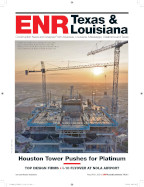Blow-down water from the chemical-free-system cooling towers flows to an exterior 260,000-gallon cistern, which will provide, at minimum, half of the water needed for irrigation. Its construction entailed a concrete reinforced wall to withstand loading, a plastic liner and plastic crates to create the form of the cistern. Atop the crates is a filter, fabric and soil, with a specific mix of sand and dirt to avoid compacting.
"The majority of the site will self-drain through the soil and [the water will] collect in the cistern," Proehl says. "The soil was mixed to project specifications before being brought on site."
Condensate from the air-conditioning system will be treated and used in toilets and urinals.
"The humidity we wring out of the air in Dallas, we are using to flush the toilets," Grant says.
Manhattan has also recycled more than 95% of the project's construction debris, including concrete and formwork.
LanDscaping Elements
The building's low-slung design hugs the Texas landscape and flows into an open space with walking trails through a park that has more than 30 different types of Texas wildflowers in a meadow, tree-shaded lawns, grass prairies, woodland clearings and a natural habitat for butterflies, birds and other wildlife.
Manhattan saved 29 existing trees during site excavation and clearing, transplanted them to a temporary tree nursery and replanted them this spring. One year before the building's anticipated opening, the team planted a total of 900 trees and 300,000 grass-seed plugs to allow them time to mature and grow.
"The site is very unusual in the sequencing," Fields says. "Normally you put the landscaping in at the end of the project, but that's not the case here."
Water from the exterior cistern and underground storage space irrigates the site. Construction crews are staying off the grass to avoid damaging the seedlings.






